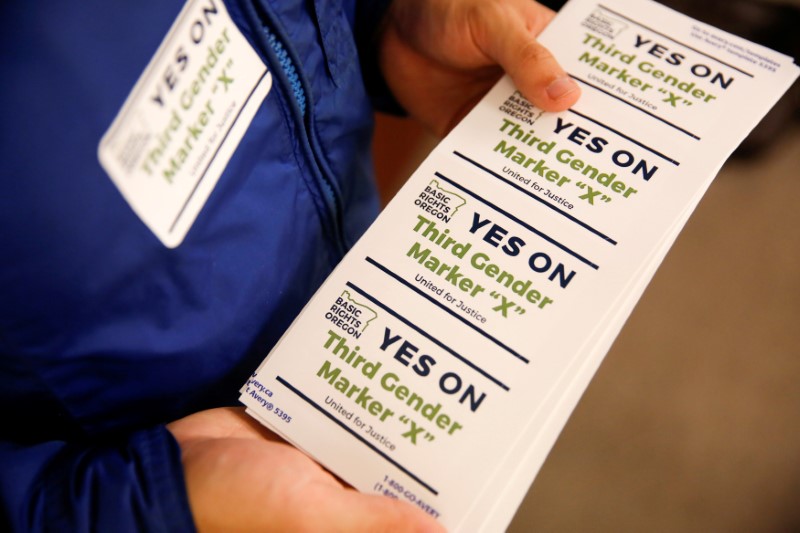Image: FILE PHOTO: An employee of the advocacy group Basic Rights Oregon hands out stickers during an Oregon Driver and Motor Vehicle department public hearing on the rights of transgender people as the state considers adding a third gender choice to driver’s licenses and identification cards, in Portland, Oregon, May 10, 2017. REUTERS/Terray Sylvester/File Photo
![]()
By Terray Sylvester
(Reuters) – Oregon on Thursday became the first U.S. state to allow residents to identify as neither male nor female on state driver’s licenses, a decision that transgender advocates called a victory for civil rights.
Under a policy unanimously adopted by the Oregon Transportation Commission, residents can choose to have an “X,” for non-specified, displayed on their driver’s license or identification cards rather than an “M” for male or “F” for female.
The policy change was cheered by supporters as a major step in expanding legal recognition and civil rights for people who do not identify as male or female. This includes individuals with both male and female anatomies, people without a gender identity and those who identify as a different gender than listed on their birth certificate.
The state’s Driver and Motor Vehicle Services Division expects to start offering the option in July.
“I very much plan to head to the nearest DMV and ask for that ID to be corrected on July 3rd,” said Jamie Shupe, an Army veteran who successfully petitioned for the non-binary gender option. “And then I’ll no doubt stand out front of the building, or sit in the car, and cry.”
Transgender rights have become a flashpoint across the United States after some states, including North Carolina, have tried to restrict transgender people’s use of public bathrooms.
At the end of May, a federal court ruled that a transgender boy must be allowed to use the boys’ bathrooms at his high school in Kenosha, Wisconsin.
The decision in Oregon comes a year after a Portland circuit court judge granted a request by Shupe to change gender from female to a third, nongender option.
That 2016 ruling prompted state officials to examine how to allow a third option in the state’s computer systems and how such a change would interact with the state’s gender laws.
During public hearings on the change, most comments were in favor, according to a summary by DMV officials.
A handful of people questioned the need for the third option and expressed concern that the change would complicate police officers’ efforts to identify people.
Having the third option on legal documentation can help reduce discrimination and raise awareness of “the spectrum of gender identity,” said Diane Goodwin, spokeswoman for Basic Rights Oregon, an advocacy group that campaigned for the “X” option.
Nearly one-third of transgender people who showed an ID with a name or gender that did not match their perceived gender reported harassment, discrimination or assault, according to a 2015 survey of more than 20,000 people in all states.
A DMV spokesman added the agency has no estimate of how many people might apply for the new IDs.
(Reporting by Terray Sylvester in Hood River, Oregon; Writing by Eric M. Johnson in Seattle; Editing by Cynthia Osterman)
Copyright 2017 Thomson Reuters. Click for Restrictions.


